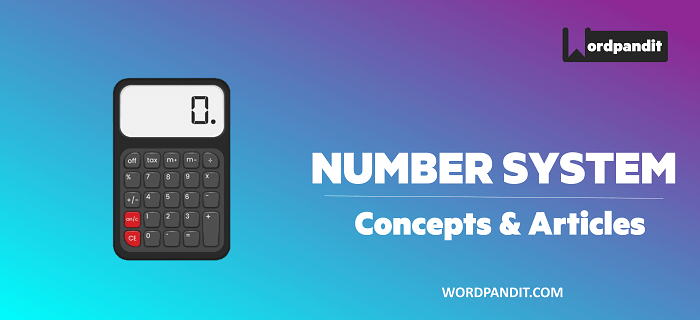In this article, you’ll learn some tricks to help you solve questions within seconds. So, let’s get going with the shortcuts.
Concept 1: Number of times a particular digit (except 0) appears in a series of numbers given
This concept can be best understood with the help of examples. This is our way of practical learning and using problem types to understand concepts.
Example 1: Calculate how many times digit 3 appears in first hundred natural numbers?
Solution:
Well, there are two series of three’s here:
- Those set of numbers, which have 3 at unit place.
3, 13,……..,83 ,93
Here we have ten 3s at the unit’s place
- Those set of numbers, which have 3 at ten’s place.
30,31…39
Here we have ten 3s at the ten’s place.
So a total of 20 threes make an appearance here.
Note:
If we have to calculate the numbers from 1- 100 which have digit 3, it would be 19. (As 33 has 3 on both places – unit and ten’s but the number 33 would be counted only once.)
Example 2: Calculate how many times digit 3 appears in natural numbers, which are less than one thousand?
Solution: In previous example we calculated number of 3s present till 100 are 20.
Now, we look at three digit numbers and calculate how many times digit 3 appears in numbers between 100 and 1000.
Well, there are three types of series here:
- Those set of numbers, which have 3 at unit place.
103, 113, 123, ……..,193
203, 213 ,………………., 293
………………………………….
903,913,………………….993
Here we have 90 numbers having 3 at the unit’s place.
- Those set of numbers, which have 3 at ten’s place.
130, 131, 132, ……..,139
230, 231, 232, ……..,239
………………………………….
930,931,………………….939
Here we have 90 numbers having 3 at the ten’s place
- Those set of numbers, which have 3 at hundred’s place.
301, 301, 302, ……..,399
Here, we have 100 3s at the hundred’s place.
Thus, total number of times digit 3 appears in natural numbers which are less than one thousand are = 20+90+90+100=300
Key Observations:
From1 – 9, the digit 3 is used 1 time.
From 1 – 99, the digit 3 is used 20 times.
From 1 – 999, the digit 3 is used 300 times.
From 1 – 9999, the digit 3 is used 4000 times and so on.
There is a pattern that can be observed in the above-mentioned observations.
Note:
Above is true for any digit except 0.
Concept 2: Unit digit of Perfect Squares
Properties regarding Unit Digit of Perfect Square
There is a definite relationship between the unit digit and ten’s digit when square of a number is considered. Let’s explore this one by one.
– If unit digit of a perfect square is 1, then ten’s digit has to be Even.
E.g. 81, 121, 441, 961 all are Perfect Square having unit digit 1 and ten’s digit is even.
– If unit digit of a number is 2, then it can’t be a perfect square.
– If unit digit of a number is 3, then it can’t be a perfect square.
– If unit digit of a perfect square is 4, then ten’s digit has to be Even.
E.g. 64, 144, 484 all are Perfect Square having unit digit 4 and ten’s digit is even.
– If unit digit of a perfect square is 5, then ten’s digit has to be 2.
E.g. 25, 225, 625,1225 all are Perfect Square having unit digit 5 and tens digit is 2.
– If unit digit of a perfect square is 6, then ten’s digit has to be Odd. e.g. 256, 576, 676, 1296, etc.
– If unit digit of a number is 7 & 8, then it can’t be a perfect square.
– If unit digit of a perfect square is 9, then ten’s digit has to be Even.
E.g. 49, 169, 529 all are Perfect Square having unit digit 9 and tens digit is even.
– If unit digit of a perfect square is 0, then ten’s digit has to be 0.
E.g. 100,400,900 all are Perfect Square having unit digit 0 and tens digit is 0.
– If a number ends with 2, 3, 7 or 8, then it can’t be perfect square.
Square of any natural number has last two digits same as that of last two digits of squares of the first twenty–five natural numbers.
For example, if we calculate the square of 88, we get 7744. You can notice that last two digits are 44, which are same as last two digits of the square of 12 i.e. 144.
That seems interesting. You can try it out for various other numbers and you’ll observe that the above-mentioned property is valid for all the numbers.
Concept 3: Perfect Number
A positive integer which is equal to the sum of its distinct proper factors is called a perfect number.
For e.g. 6 is a perfect number as the proper factors of 6 are 1, 2 and 3 and 6 = 1 + 2 +3
Now let us check whether 28 is a perfect number.
The proper factors of 28 are 1 , 2, 4, 7 and 14.
We have Sum of proper factors = 1+2+4+7+14= 28.
Therefore, 28 is a perfect number.
These concepts above are useful acquire speed in problem solving.
Let us also go through some more tricks and patterns that we see dealing with ‘Numbers’
The Magic of Numbers
- Magical 1
3 x 37 = 111
33 x 3367 = 111,111
333 x 333667 = 111,111,111
3333 x 33336667= 111,111,111,111
33333 x 3333366667= 111,111,111,111,111
333333 x 333333666667 = 111,111,111,111,111,111
Consider the L.H.S of the above numbers. The number of 3s in both the numbers are same and 6 is one less than the number of 3 and there is only one 7. Then in the final product, 1 would appear three times the number of threes in the first number on the LHS.
- 6 when multiplied with 7 give 4s and 2s
6 x 7 = 42
66 x67 = 4422
666 x 667 = 444222
6666 x 6667 = 44442222
For multiplication such as the above:
The number of digits in both the numbers is same, the 2nd number has one 6 less than the number of 6’s in the 1st number.
The number of 4’s and 2’s is equal to the number of 6’s in the 1st number
- Cyclic numbers
142857 is called as the cyclic number, since its digits are rotated around when multiplied by any number from 1 to 6
142857 x 1 = 142857
142857 x 5= 714285
142857 x 4= 571428
142857 x 6 = 857142
142857 x 2= 285714
142867 x 3 = 428571
The same method helps us calculating fractions involving 7 in denominator

We know that = 0.142857
Thus,![]() will be a value close to 0.28 and directly we will write exact answer as numbers repeat in cyclic order as shown in diagram. Hence exact answer will be 0.285714
will be a value close to 0.28 and directly we will write exact answer as numbers repeat in cyclic order as shown in diagram. Hence exact answer will be 0.285714
Similarly, ![]() will be a value close to 0.42 and directly we will write exact answer as numbers repeat in cyclic order as shown in diagram. Hence exact answer will be 0.428571
will be a value close to 0.42 and directly we will write exact answer as numbers repeat in cyclic order as shown in diagram. Hence exact answer will be 0.428571
Similarly, ![]() will be a value close to 0.56 and directly we will write exact answer as numbers repeat in cyclic orderas shown in diagram. Hence exact answer will be 0.571428
will be a value close to 0.56 and directly we will write exact answer as numbers repeat in cyclic orderas shown in diagram. Hence exact answer will be 0.571428
Similarly, ![]() will be a value close to 0.7 and directly we will write exact answer as numbers repeat in cyclic orderas shown in diagram. Hence exact answer will be 0.714285
will be a value close to 0.7 and directly we will write exact answer as numbers repeat in cyclic orderas shown in diagram. Hence exact answer will be 0.714285
Similarly, ![]() will be a value close to 0.84 and directly we will write exact answer as numbers repeat in cyclic order as shown in diagram. Hence exact answer will be 0.857142
will be a value close to 0.84 and directly we will write exact answer as numbers repeat in cyclic order as shown in diagram. Hence exact answer will be 0.857142










